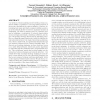Free Online Productivity Tools
i2Speak
i2Symbol
i2OCR
iTex2Img
iWeb2Print
iWeb2Shot
i2Type
iPdf2Split
iPdf2Merge
i2Bopomofo
i2Arabic
i2Style
i2Image
i2PDF
iLatex2Rtf
Sci2ools
GECCO
2010
Springer
2010
Springer
Evolving viral marketing strategies
One method of viral marketing involves seeding certain consumers within a population to encourage faster adoption of the product throughout the entire population. However, determining how many and which consumers within a particular social network should be seeded to maximize adoption is challenging. We define a strategy space for consumer seeding by weighting a combination of network characteristics such as average path length, clustering coefficient, and degree. We measure strategy effectiveness by simulating adoption on a Bass-like agent-based model, with five different social network structures: four classic theoretical models (random, lattice, small-world, and preferential attachment) and one empirical (extracted from Twitter friendship data). To discover good seeding strategies, we have developed a new tool, called BehaviorSearch, which uses genetic algorithms to search through the parameter-space of agent-based models. This evolutionary search also provides insight into the...
| Added | 19 Jul 2010 |
| Updated | 19 Jul 2010 |
| Type | Conference |
| Year | 2010 |
| Where | GECCO |
| Authors | Forrest Stonedahl, William Rand, Uri Wilensky |
Comments (0)

